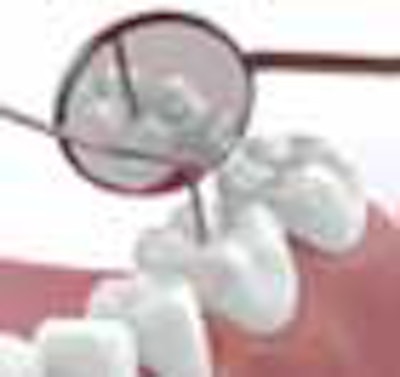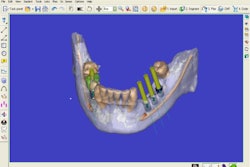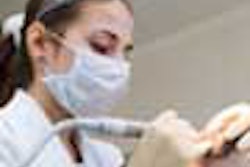
Slap on some hydrogen peroxide and it's amazing what disappears from a tooth: bacteria, wine stains, even tetracycline coloring. But dental researchers have long wondered if anything more important disappears as well -- such as some of the tooth itself. And in a recent spate of studies, they've come up with worrisome answers.
Enamel, it seems, can tolerate a pretty harsh splash of bleach. But dentin is another matter, says Laura Tam, D.D.S., an associate professor of restorative dentistry at the University of Toronto. In laboratory experiments reported in the April Journal of Esthetic and Restorative Dentistry, she found that even a 3 percent solution of hydrogen peroxide saps human dentin. "Dentists should be careful in bleaching those teeth with exposed dentin," she warned.
Further clues about this process come from researchers at Wuhan University and HuaZhong University in China, who write in the November Journal of Dental Research that hydrogen peroxide hits dentin with a double whammy: it oxidizes the organic components and dissolves the minerals.
But one bleaching expert, Van Haywood, D.M.D., a professor of oral rehabilitation at the Medical College of Georgia, pooh-poohed these laboratory findings as irrelevant to the real world of patients' mouths. "From what I can see, there is not a serious enough effect to be concerned about," said Dr. Haywood, who first developed carbamide bleaching. In its standard formula, carbamide peroxide contains 3 percent hydrogen peroxide plus urea.
The question has gotten more urgent as more people have been using at-home bleaching kits; one survey found as many as 95 percent of dentists prescribe such products to their patients. But since the kits are marketed as cosmetic treatments, there's little regulation. Dr. Tam has seen solutions as high as 22 percent carbamide peroxide, the equivalent of 8 percent hydrogen peroxide.
For their experiments, Dr. Tam and her colleagues cut notches in 80 extracted human molars. These notches exposed the dentin in the teeth. They then randomly divided the teeth into five groups of 16 teeth and applied a different solution to each group: 10 percent carbamide peroxide, 3 percent hydrogen peroxide, 30 percent hydrogen peroxide, glycerin, or distilled water.
Each group of 16 teeth was subdivided into two groups of eight: direct and indirect bleaching. In the indirect bleaching groups, the researchers put the bleach only on the enamel -- avoiding the dentin exposed in the notches. The idea was too see if any bleach seeped through the enamel and damaged the dentin. In the direct bleaching groups, bleach was applied directly onto the dentin exposed in the notches.
Then they mounted the teeth one by one on an Instron universal testing machine and increased the pressure gradually, measuring the force until each tooth cracked.
The results? The teeth in the indirect bleaching group were just as strong as the teeth treated with only water or glycerin. These teeth all had fracture toughness (K1c) ranging from 2.66 to 3.33 (MPa*M^0.5). Apparently, not enough bleach seeped through the enamel to cause any damage.
But teeth whose dentin was bleached directly with 30 percent hydrogen peroxide solutions were significantly weaker: they had a K1c of 1.6. Another notable finding: teeth whose dentin was treated directly with carbamide peroxide fared no better. They had a K1c of 1.38 -- a surprise, since carbamide peroxide has been touted as a safer bleach.
The teeth with dentin directly exposed to 3 percent hydrogen peroxide fell in the middle of the toughness range, with a K1c of 2.45.
How to prevent damage
The study suggests that even relatively mild bleach solutions -- including carbamide peroxide -- can damage exposed dentin, Dr. Tam said. She advises dentists to "use the lowest concentration possible of hydrogen peroxide and the shortest amount of exposure."
For patients with receding gums, she recommends that dentists cut bleaching trays so they don't overlap the exposed root. Teeth with worn-out enamel pose a bigger problem. "In cases of severe occlusal attrition, avoid bleaching or use in-office bleaching so you can control where the bleach goes."
Dr. Haywood agreed that 30 percent hydrogen peroxide shouldn't be used any more. But he said cola is a bigger threat to patients' teeth than carbamide peroxide. "Put this in perspective of the things people are using in their mouths," he said.
His point of view got support from a study in the current issue of the Journal of Clinical Dentistry -- sponsored by Procter & Gamble -- which makes Crest Whitestrips. The study found that hydrogen peroxide solutions at 5.3 and 6.5% concentrations did not damage dentin.
As for exposed dentin, "when you have worn your occlusal surfaces down to the point where you have exposed dentin, you have a serious bite problem that far exceeds the risk from bleaching," he said.
Over-the-counter hydrogen peroxide remains safe as an antibacterial rinse used for caries prevention, Dr. Haywood said, but he advocated carbamide peroxide as a superior treatment.
He also commented on a report in the April Journal of Endodontics that showed dentin damage from five types of bleach used inside teeth that have had root canal treatment: sodium perborate and water; sodium perborate and 2 percent chlorhexidine gel; sodium perborate and 30 percent hydrogen peroxide; 37 percent carbamide peroxide gel; and 37 percent carbamide peroxide gel and 2 percent chlorhexidine gel.
Compared to water alone, which was used as a control, all these bleaches weakened the dentin, the researchers found, with the solutions using carbamide peroxide doing the least damage and the solutions containing hydrogen peroxide doing the most. While the effect was not big enough for dentists to stop using carbamide peroxide as a "walking" bleach, Dr. Haywood argued, they should abandon 30 percent hydrogen peroxide for this purpose.



















